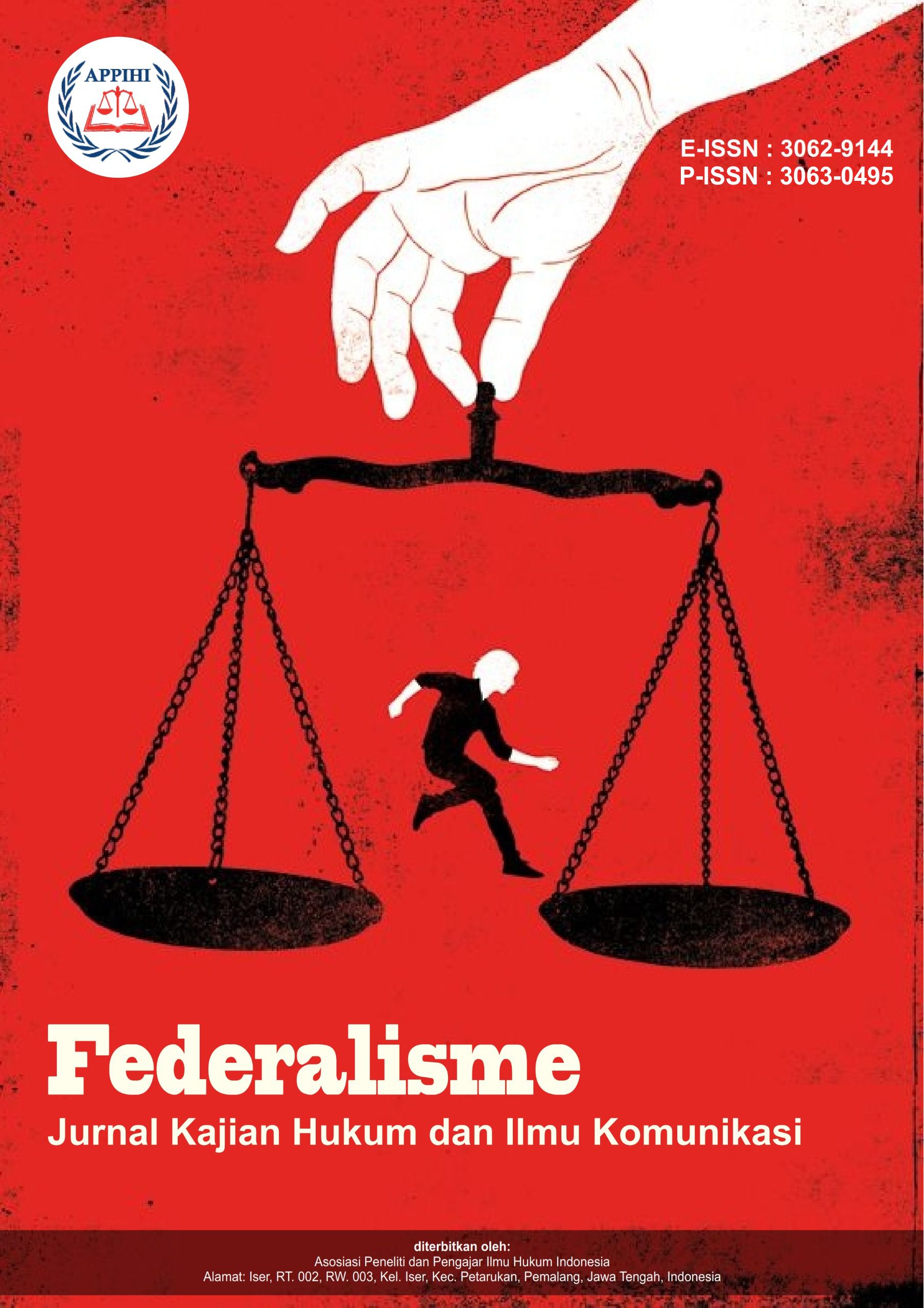Pengaruh Penggunaan Platform Komunikasi Digital terhadap Hubungan Sosial Remaja di SMK Negeri 2 Binjai
DOI:
https://doi.org/10.62383/federalisme.v2i3.844Keywords:
digital communication platform, adolescent, social relationsAbstract
To determine the effectiveness of using digital communication platforms on social relations among adolescents at SMK Negeri 2 Binjai is the aim of this study. Simple linear regression analysis is the method used. Simple linear regression analysis was conducted after the classical acceptance test. This is to first ensure that the model does not have problems with normality, multicollinearity, and heteroscedasticity. 30 young people from SMK Negeri 2 Binjai as the population in this study. Based on the results above, we can see that the coefficient of determination (R2) value is 0.60 or 60%. Therefore, this value means that the variables in the use of digital communication platforms have a 60% impact on social relationships, and the remaining 40% of other variables not discussed in this study are affected. To get meaning and satisfaction from digital communication, we can approach this means of interaction with intention and authenticity. Text messages are edited many times and sent to several friends to be edited before finally being sent to the recipient do not always fully represent our true feelings.
Downloads
References
Astuti, C. N., & Kusumiati, R. Y. (2021). Partisipasi pembudidaya ikan dalam kelompok usaha akuakultur di Kabupaten Tasikmalaya. Jurnal Ilmiah Bimbingan Konseling Undiksha, 12(2).
Budi, A. D. A. S., Septiana, L., & Mahendra, B. E. P. (2024). Asumsi klasik dalam analisis statistik: Multikolinearitas, heteroskedastisitas, dan autokorelasi. Jurnal Multidisiplin West Science, 3(1), 1–11.
Darma, B. (2021). Statistika penelitian menggunakan SPSS. Penerbit XYZ.
Farikha, I. S. (2023). Pengaruh media sosial TikTok terhadap etika berpakaian siswa kelas XI di SMA Muhammadiyah 1 Muntilan, Kabupaten Magelang [Skripsi, Universitas Muhammadiyah Magelang].
Fensi, F. (2023). Komunikasi digital: Konsensus dan indoktrinasi ideologi kolektif. Jejak Pustaka.
Grimonia, E. (2023). Dunia musik: Sains-musik untuk kebaikan hidup. Nuansa Cendekia.
Hamzah, N. F., Mirza, M., & Pradesti, A. (2024). Komunikasi antar pribadi dalam pembentukan karakter anak oleh orang tua. TUTURAN: Jurnal Ilmu Komunikasi, Sosial dan Humaniora, 2(1), 184–194.
Indriani, A. (2020). Analisis faktor-faktor yang memengaruhi audit delay. Jurnal Akuntansi dan Ekonomika, 10(2), 198–205.
Kadri, W. N., & Andika, A. Y. D. (2022). Dampak penggunaan media sosial TikTok terhadap pola komunikasi efektif mahasiswa Ilmu Komunikasi Universitas Muhammadiyah Kotabumi. Komsospol, 2(1), 1–11.
Kase, E., Mahendika, D., & Laksmono, R. (2023). Manajemen komunikasi pendidikan. Penerbit XYZ.
Mardiatmoko, G. (2020). Pentingnya uji asumsi klasik pada regresi linier berganda: Studi kasus persamaan allometrik kenari muda (Canarium indicum L.). BAREKENG: Jurnal Ilmu Matematika dan Terapan, 14(3), 333–342.
Matney, L. (2016). Snapchat hits 6 billion daily video views—tripling since May. TechCrunch. https://techcrunch.com
Nawaz, I. Y. (2020). Characteristics of millennials and digital technology adoption. In Handbook of Research on Innovations in Technology and Marketing for the Connected Consumer (pp. 241–262). IGI Global.
Prihatiningsih, D. (2022). Mudahnya belajar statistik deskriptif. CV. Sarnu Untung.
Renggo, Y. R., & Kom, S. (2022). Populasi dan sampel dalam penelitian kuantitatif, kualitatif dan kombinasi. In Metodologi Penelitian Kuantitatif, Kualitatif dan Kombinasi (p. 43). Penerbit XYZ.
Retnowati, Y. (2021). Pola komunikasi dan kemandirian anak: Panduan komunikasi untuk orang tua tunggal. Mevlana Publishing.
Ruan, B., Yilmaz, Y., Lu, D., Lee, M., & Chan, T. M. (2020). Definisi diri digital dalam identitas profesional di bidang kesehatan. Journal of Medical Internet Research, 22(9), e21416. https://doi.org/10.2196/21416
Sayekti, R. N. S., Rifa’i, M., & Yanti, D. A. W. (2024). Transformasi digital dan dampaknya pada kinerja UMKM. Journal of Indonesian Economic Research, 2(1), 30–40.
Setyawati, R. (2023). Pengaruh kualitas pelayanan terhadap kepuasan konsumen. Inovasi: Jurnal Ekonomi, Keuangan, dan Manajemen, 19(1), 57–63.
Sugiyono. (2017). Metode penelitian kuantitatif, kualitatif, dan R&D. CV. Alfabeta.
Wibowo, A. (2022). Transformasi ekonomi digital (hlm. 1–179). Yayasan Prima Agus Teknik.
Yusuf, M. A., Herman, H., Abraham, A., & Rukmana, H. (2024). Analisis regresi linier sederhana dan berganda beserta penerapannya. Journal on Education, 6(2), 13331–13344.
Zakariah, M. A., & Afriani, V. (2021). Analisis statistik dengan SPSS untuk penelitian kuantitatif. Yayasan Pondok Pesantren Al Mawaddah Warrahmah Kolaka.
Downloads
Published
How to Cite
Issue
Section
License
Copyright (c) 2025 Federalisme: Jurnal Kajian Hukum dan Ilmu Komunikasi

This work is licensed under a Creative Commons Attribution-ShareAlike 4.0 International License.






